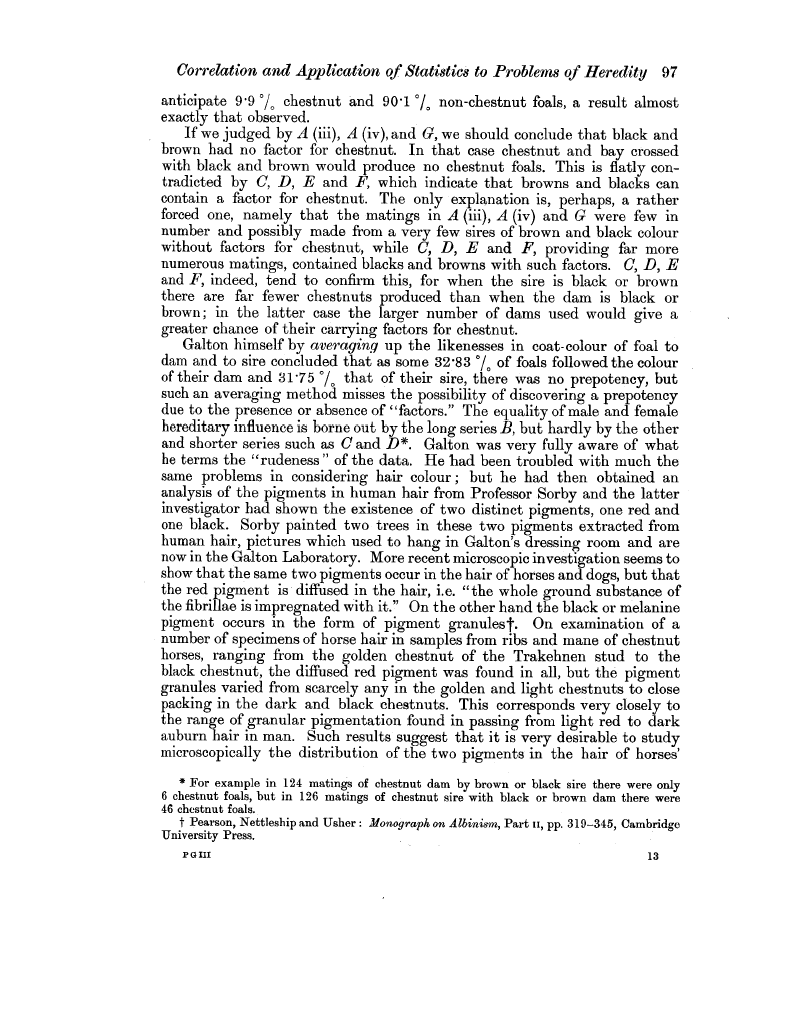| ||||||

OCR Rendition - approximate
Correlation and Application of Statistics to Problems of Heredity 97 anticipate 9.9 °/O chestnut and 90.1 0/, non-chestnut foals, a result almost exactly that observed. If we judged by A (iii), A (iv), and G, we should conclude that black and brown had no factor for chestnut. In that case chestnut and bay crossed with black and brown would produce no chestnut foals. This is flatly contradicted by C, D, E and F which indicate that browns and blacks can contain a factor for chestnut. The only explanation is, perhaps, a rather forced one, namely that the matings in A (iii), A (iv) and G were few in number and possibly made from a very few sires of brown and black colour without factors for chestnut, while C, D, E and F, providing far more numerous rnatings, contained blacks and browns with such factors. C, D, E and F, indeed, tend to confirm this, for when the sire is black or brown there are far fewer chestnuts produced than when the dam is black or brown; in the latter case the larger number of dams used would give a greater chance of their carrying factors for chestnut. Galton himself by averaging up the likenesses in coat-colour of foal to dam and to sire concluded that as some 32.83 °/a of foals followed the colour of their dam and 31.75 °/o that of their sire, there was no prepotency, but such an averaging method misses the possibility of discovering a prepotency due to the presence or absence of "factors." The equality of male and female hereditary influence is borne out by the long series B, but hardly by the other and shorter series such as C and D*. Galton was very fully aware of what he terms the "rudeness " of the data. He head been troubled with much the same problems in considering hair colour ; but he had then obtained an analysis of the pigments in human hair from Professor Sorby and the latter investigator had shown the existence of two distinct pigments, one red and one black. Sorby painted two trees in these two pigments extracted from human hair, pictures which used to hang in Galton s dressing room and are now in the Galton Laboratory. More recent microscopic investigation seems to show that the same two pigments occur in the hair of horses and dogs, but that the red pigment is diffused in the hair, i.e. "the whole ground substance of the fibrillae is impregnated with it." On the other hand the black or melanine pigment occurs in the form of pigment granules'. On examination of a number of specimens of horse hair in samples from ribs and mane of chestnut horses, ranging from the golden chestnut of the Trakehnen stud to the black chestnut, the diffused red pigment was found in all, but the pigment granules varied from scarcely any in the golden and light chestnuts to close packing in the dark and black chestnuts. This corresponds very closely to the range of granular pigmentation found in passing from light red to dark auburn hair in man. Such results suggest that it is very desirable to study microscopically the distribution of the two pigments in the hair of horses' * For example in 124 matings of chestnut dam by brown or black sire there were only 6 chestnut foals, but in 126 matings of chestnut sire with black or brown dam there were 46 chestnut foals. t Pearson, Nettleship and Usher : Monograph on Albinism, Part ii, pp. 319-345, Cambridge University Press. P G III 13
|